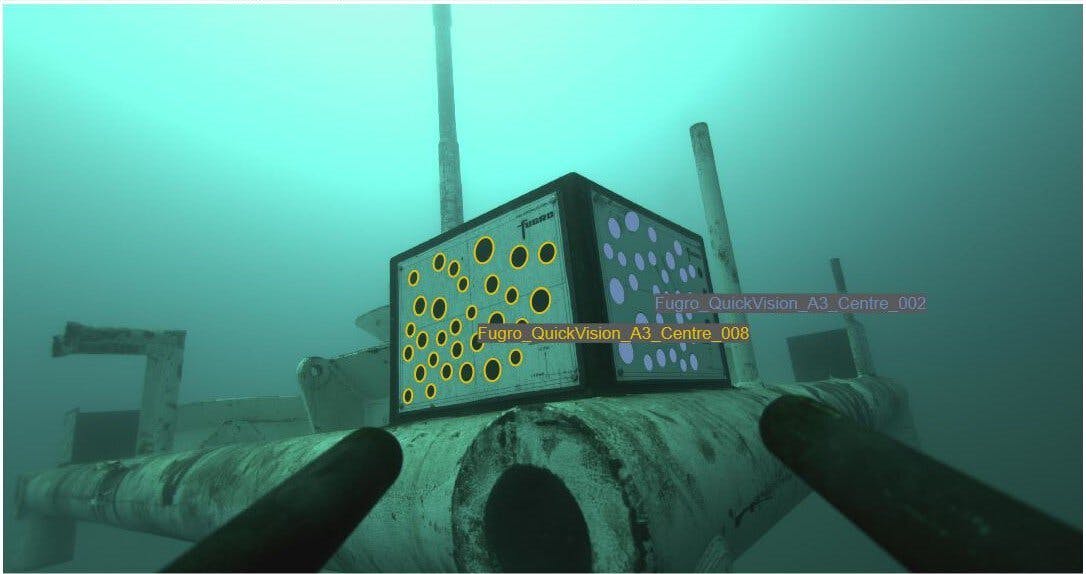Case study
QuickVision® technology reduces pile positioning time by 75%
Offshore Qatar

Client
Doha Petroleum Construction Company Limited (DOPET)
Project duration
October 2021 - November 2021
Fugro’s innovative QuickVision® touchless technology for the subsea stabframe saved the Doha Petroleum Construction Company (DOPET) a full day of barge time when installing seven subsea piles in offshore Qatar.
Life cycle
Planning, feasibility, conceptual design
Design
Construction
Operations and maintenance
Decommissioning
Show full process

Vision technology
QuickVision®
A patented smart camera that provides accurate subsea asset positioning during drilling and construction support operations to reduce overall time, costs and HSSE risks for your offshore project
QuickVision®
The QuickVision® is a patented smart camera that provides accurate subsea asset positioning during drilling and construction support operations to reduce overall time, costs and risks for your project.
Installation time of one pile
minutes
Challenge
DOPET commissioned Fugro to position a subsea stabframe in November 2021. This activity was on the project’s critical path: the frame was to play a vital role in positioning seven mooring piles that were to be hammered into the seabed with pinpoint accuracy. The client needed a fast, efficient, cost-effective and reliable positioning solution. Triangulated beacon signals are traditionally used to determine the exact frame position, but the process is time-consuming because each pile takes around an hour to position. Occasionally the beacon technology fails. And signal diffraction can also sometimes interfere with the measurement process.
Solution
We had originally been contracted by DOPET to deliver a conventional positioning service: using beacon technology to position a subsea stabframe for the installation of seven mooring piles. Within days of the project award, our patented QuickVision® technology became available to the Middle East and India region. After careful analysis, ample project optimisation opportunity was spotted and Fugro team together with the client worked on an approach to integrate QuickVision® in the scope of work. The team at our newly launched Remote Operations Centre (ROC) in Qatar wasted no time in alerting DOPET to the added value and multiple client benefits that QuickVision® could deliver.
New positioning method offers added value
Our team held a series of meetings with DOPET to explain our QuickVision® contactless solution and the many client benefits it provides. The client was impressed with this innovative remote positioning technology and its high levels of accuracy. The prospect of achieving significant project optimisation was also highly attractive, resulting in cost and time benefit. DOPET readily agreed to us switching our positioning service method from beacon technology to QuickVision®.
Positioning the subsea assets
While the stabframe was being lowered carefully into position, QuickVision®’s high-fidelity image stream enabled the onboard Fugro and DOPET teams to view subsea installation process on screen in real time.
DOPET’s crane operator was also able to validate the actual position of the subsea stabframe instantly on screen. As a result, he positioned the frame very quickly and accurately on the seabed at each of seven locations, ready for it to be used for the pile installation. We stuck a QuickVision® pattern onto each pile and used for accurate installation. A pattern was also affixed to the first chaser pile, to guide its landing. In one pile location it was not possible to place the stabframe on its mud mats. To enable operations to continue, we used the QuickVision® inclinometer to measure the pile’s verticality, which was within tolerance. The post-project evaluation confirmed that entire operation was smooth, fast and cost-effective.

QuickVision® marking for precise frame positioning.

Subsea structure using QuickVision®, Fugro's contact-less vision based (subsea) positioning and Augmented Reality measurement too
Innovative highlight
Fugro’s patented QuickVision® technology combines a state-of-the-art subsea camera and patented machine vision algorithms. Adhesive coded targets (dotted patterns) are stuck onto the structure before it is lowered into the water. The remotely operated QuickVision® camera then accurately tracks and measures the position, heading and attitude of the targets as the structure is landed, and validates that it is within specification. QuickVision® visualises the data and allows authorised users on the vessel to view it in real-time.
“Faster positioning of the frame might seem like a small improvement. But for a project like this it reduces one day of costly barge time. Time reduction and improved quality assurance are what matter to us.”
Srinivas Sirigineedi
Senior Project Engineer, DOPET
Impact
Fugro’s QuickVision® solution delivered many important benefits to DOPET on this project:
Reduced cost – QuickVision® saved a full day of expensive barge time
Safer, cheaper operations – this contactless solution obviated the need for personnel to install and remove bulky subsea sensors
Faster installation of each mooring pile (15 minutes rather than one hour)
Real-time information – this eradicated delays in processing or interpreting the structure's position
Instant validation – the crane operator’s on-screen overview was the actual position of the structure
Quicker cross-referencing at each pile location (five minutes rather than half an hour)

What we do at Fugro